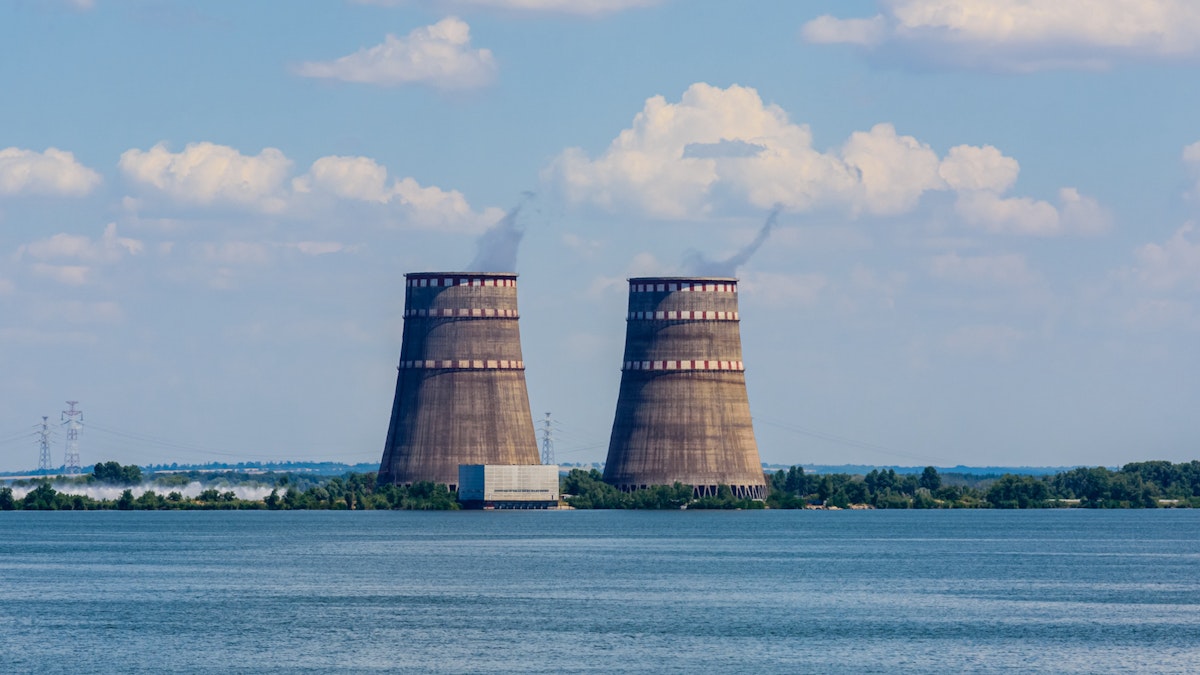Can you Steal a Nuclear Reactor? Russia May Try
Ukraine's Zaporizhzhia reactor complex was seen as target—now, it looks like it might be war booty.

-
-
Share
-
Share via Twitter -
Share via Facebook -
Share via Email
-
Early in the Russian invasion of Ukraine, some people thought that the Zaporizhzhia reactor complex was a target. But now, it looks like it might be war booty.
Energoatom, the Ukrainian state nuclear company, said in a statement available on Facebook that shelling had shut down the last two high-voltage lines connecting the plant to the Ukrainian grid, and that “Such actions are another attempt by the Russians to connect the nuclear plant to the Russian energy system,” via “temporarily occupied Crimea and Donbas.”
What exactly does that mean?
Potentially, producing billions of dollars’ worth of electricity from the captured plant, and sending it back across the border.
And there is now a border, electrically speaking. In addition to a dotted line on a map dividing Russia and Ukraine (now a matter of dispute because of Russian annexations), there is an electrical border between Russia and Ukraine, because their grids have been severed.
Both are alternating current power systems, which are employed around the world because they allow the connection of hundreds of generators and hundreds or thousands of substations. In an AC system, the grid is not reliant on any single generator to maintain reliability. A grid allows system operators to adjust generation as demand varies over the course of the day or week or year, starting some generators up, shutting others down, and adjusting their level of output. Among other considerations, it lets the operators configure the system so that at any moment, the least expensive ensemble of generators is running.
But for two generators to serve the same system, they have to be synchronized. That is, the electrons have to be dancing back and forth in lockstep. Energy on the grid is a bit like a line of dancing Rockettes, each kicking at exactly the same instant. In the United States, with a 60-cycle system, that means the flow of electrons reverses 120 times a second. Europe is on a 50-cycle system, or 100 reversals per second.
Europe and Russia both use 50 cycles, but they are not synchronized, or kicking at exactly the same moment. For decades, Ukraine had been synched to Russia.
Beginning in March, however, with Ukraine convinced that hostilities were coming, the country unplugged itself from the Russian grid and synchronized itself with the 35-country European Network of Transmission System Operators for Electricity, known as ENTSO-E, which describes itself as the largest interconnected grid in the world.
Adjacent grids that are out of sync are common. North America has three large ones: the Eastern Interconnection, which stretches from Halifax, Nova Scotia, to New Orleans; the Western Interconnection, which runs from British Columbia to the northern fringe of Mexico; and Texas. Energy can be transferred from one grid to another, but it is expensive and cumbersome, usually requiring conversion to direct current and then back to alternating current.
Among the advantages of Ukraine turning its back on Russia and facing west instead, electrically speaking, is that if Ukrainian generators were damaged in the fighting, generators to the west of the country could supply electricity, if the transmission system allowed. And the European grid could be counted on to supply as much energy as was physically possible, unlike the Russian grid, which could shut down connections just as the Nord Stream natural gas pipeline was shut down.
What Energoatom asserts, and which a variety of Ukrainian engineers have said they feared, is that Russia wants to synchronize the reactors’ generators to Crimea and Donbas, both Russian-occupied and now part of the Russian grid. The fear is not that an invader would deliberately damage a plant in order to release some of its inventory of radioactive materials, but that it would capture a plant and use it as if it were a valuable capital asset – which it is. Six 1,000-megawatt reactors have a replacement value of tens of billions of dollars.
The extra supplies of electricity from Zaporizhzhia would reduce the amount of gas, oil, and coal that Russia would have to produce to fuel its grid; alternatively, it could free up those fossil fuels for export. Russia, which last year was the world’s third-largest oil producer, behind Saudi Arabia and the United States, has used its energy production as a geopolitical tool since Soviet times. In fact, its production was so crucial to the world economy in the Soviet years that the Central Intelligence Agency even published an atlas of Soviet energy facilities.
Zaporizhzhia was once one of those facilities; construction began there in 1980, eleven years before the fall of the Soviet Union.
The six reactors are of a Russian design commonly used around the Soviet Union. It was designed for Russian-fabricated fuel, although after the fall of the Soviet Union, Ukraine began buying fuel from Westinghouse, which produced a special product to fit the Russian reactors. They all run on uranium, but like cell phone batteries or computer cables, they differ in fine detail, so they are not interchangeable.
As of early November, the six generators have not been synchronized to the Russian grid; they simply are not running at all. And the front lines have been moving, as one side or the other takes territory.
The use of heavy weapons near nuclear reactors is not optimal, of course. But the buildings housing critical systems are designed to withstand tremendous pressures and are among the most sturdy on earth.
A characteristic common to advanced reactor designs is that most critical systems are below grade level. In some cases, this is to simplify security. (Most reactors now operating were designed long before owners thought of truck bombs and similar threats.) In some cases, putting them underground allows for the passive dissipation of excess heat if something goes wrong with the cooling system. In either case, their vulnerability is reduced.
Russia has already removed the bones of an 18th-century military commander, Grigory Potemkin, from Ukraine. Mariupol officials say that Russians pilfered museums when they captured that city. Reactors are immobile, but their product isn’t. And Russian actions may soon confirm them as among Ukraine’s most valuable assets.


